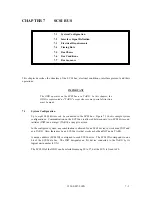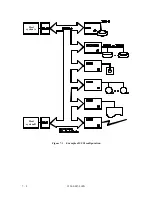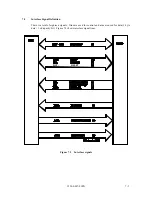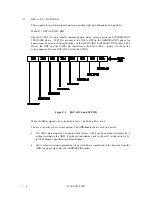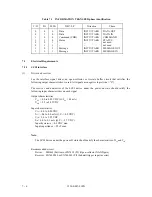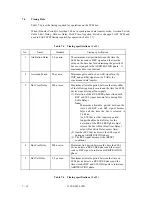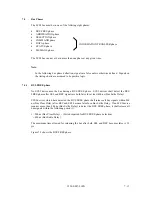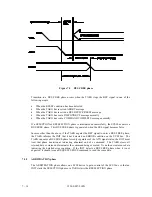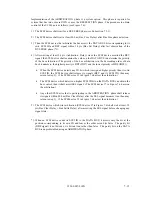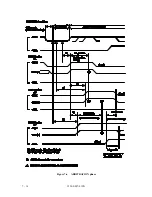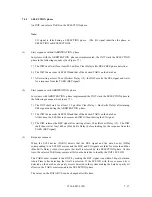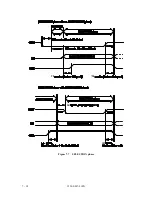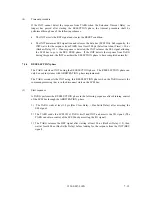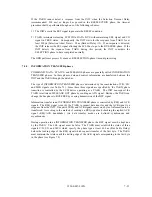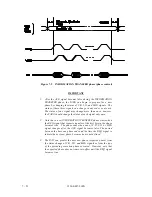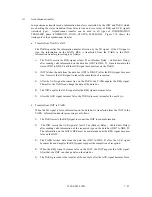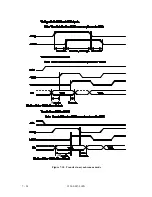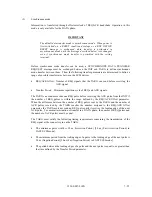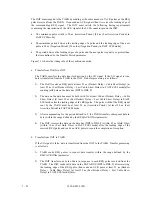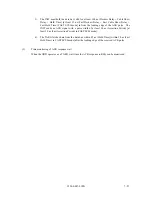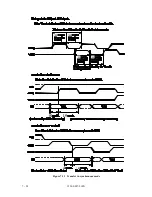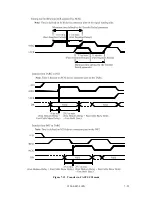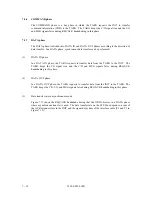
C156-E097-01EN
7 - 15
Implementation of the ARBITRATION phase is a system option. This phase is required for
system that has two or more INITs or uses the RESELECTION phase. The procedure to obtain
control of the SCSI bus is as follows (see Figure 7.6):
1) The SCSI device shall wait for a BUS FREE phase (see Subsection 7.5.1).
2) The SCSI device shall wait at least 800 ns (Bus Free Delay) after Bus Free phase detection.
3) Then the SCSI device that arbitrates the bus asserts the DATA BUS bit corresponding to its
own SCSI ID and BSY signal within 1.8
µ
s (Bus Set Delay) after last observation of the
BUS FREE phase (*1).
4) After waiting at least 2.4
µ
s (Arbitration Delay) since the SCSI device asserted the BSY
signal, the SCSI device shall examine the value on the DATA BUS to determine the priority
of the bus arbitration. (The priority of the bus arbitration is in the descending order of data
bus bit numbers; the highest priority is DB7 (ID#7) and the lowest priority is DB0 (ID#0)).
•
When the SCSI device detects any ID bit which is assigned higher priority than its own
SCSI ID, the SCSI device shall release its signals (BSY and its SCSI ID), then may
return to step 1). (The SCSI device #1 in Figure 7.6 has lost the arbitration.)
•
The SCSI device which detects no higher SCSI ID bit on the DATA BUS can obtain the
bus control, then it shall assert SEL signal. (The SCSI device #7 in Figure 7.6 has won
the arbitration.)
•
Any other SCSI device that is participating in the ARBITRATION phase shall release
its signals within 800 ns (Bus Clear Delay) after the SEL signal becomes true, then may
return to step 1). (The SCSI device #3 in Figure 7.6 has lost the arbitration.)
5) The SCSI device which wins arbitration (SCSI device #7 in Figure 7.6) shall wait at least 1.2
µ
s (Bus Clear Delay + Bus Settle Delay) after asserting the SEL signal before changing any
signal state.
*1: When an SCSI device sends its SCSI ID to the DATA BUS, it asserts only the bit at the
position corresponding to its own ID and leaves the other seven bits false. The parity bit
(DBP signal) is not driven or is driven true, rather than false. The parity bit on the DATA
BUS is unpredictable during an ARBITRATION phase.
Summary of Contents for MCE3064SS
Page 1: ...C156 E097 01EN MCE3064SS MCF3064SS OPTICAL DISK DRIVES PRODUCT MANUAL ...
Page 3: ...This page is intentionally left blank ...
Page 31: ...This page is intentionally left blank ...
Page 52: ...C156 E097 01EN 2 21 Figure 2 3 Example of alternate processing ...
Page 53: ...This page is intentionally left blank ...
Page 72: ...C156 E097 01EN 3 19 Figure 3 17 SCSI cable connector ...
Page 81: ...This page is intentionally left blank ...
Page 97: ...4 16 C156 E097 01EN Figure 4 5 SCSI connection check 2 ...
Page 99: ...This page is intentionally left blank ...
Page 113: ...This page is intentinally left blank ...
Page 119: ...7 2 C156 E097 01EN Host system A Host system B Figure 7 1 Example of SCSI configuration ...
Page 133: ...7 16 C156 E097 01EN Figure 7 6 ARBITRATION phase ...
Page 135: ...7 18 C156 E097 01EN µ Figure 7 7 SELECTION phase 30 30 30 30 ...
Page 141: ...7 24 C156 E097 01EN Figure 7 10 Transfer in asynchronous mode 18 18 ...
Page 145: ...7 28 C156 E097 01EN Figure 7 11 Transfer in synchronous mode 11 11 11 11 43 18 43 18 ...
Page 146: ...C156 E097 01EN 7 29 Figure 7 12 Transfer in FAST SCSI mode ...
Page 148: ...C156 E097 01EN 7 31 Figure 7 13 Data transfer rate in asynchronous mode ...
Page 158: ...C156 E097 01EN 7 41 Figure 7 17 RESET condition ...
Page 160: ...C156 E097 01EN 7 43 Figure 7 18 Bus phase sequence 1 of 2 ...
Page 161: ...7 44 C156 E097 01EN Figure 7 18 Bus phase sequence 2 of 2 ...
Page 167: ...This page is intentionally left blank ...
Page 171: ...This page is intentionally left blank ...
Page 181: ......

